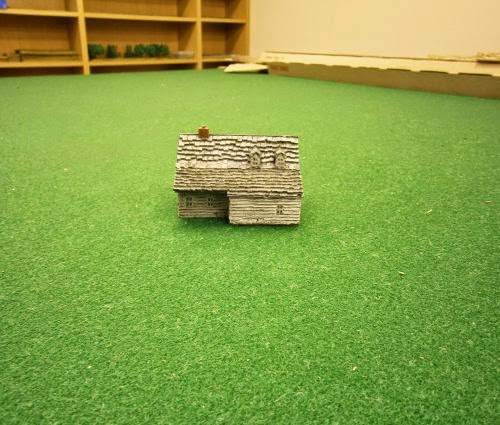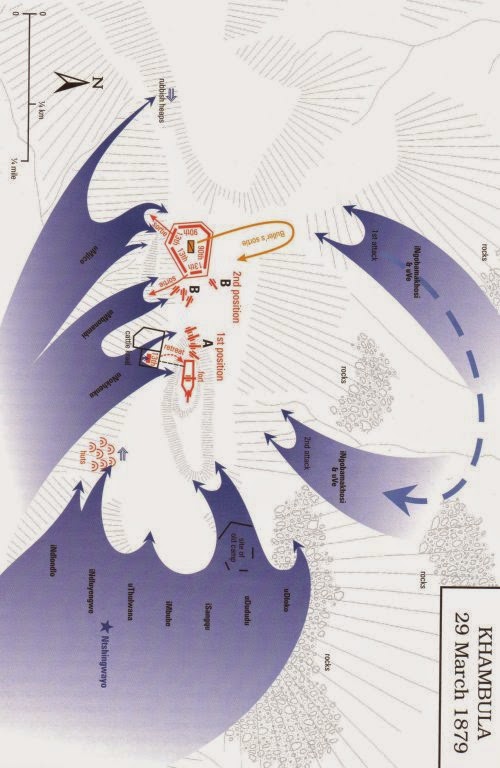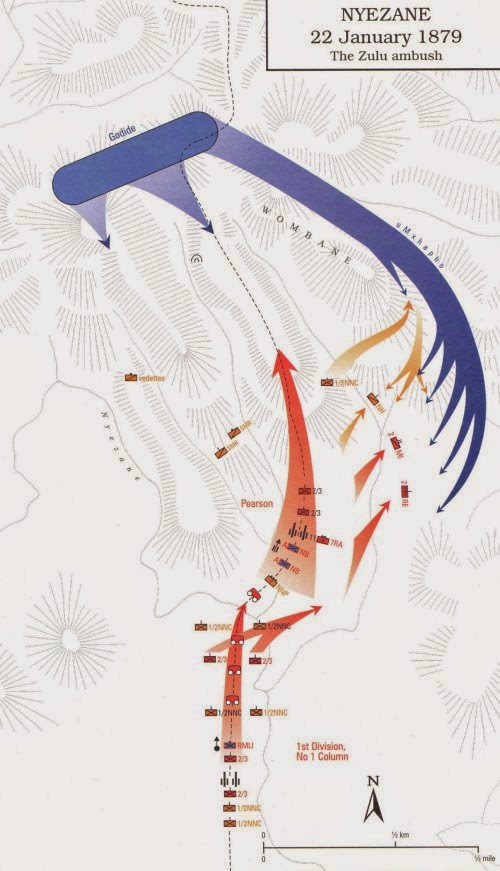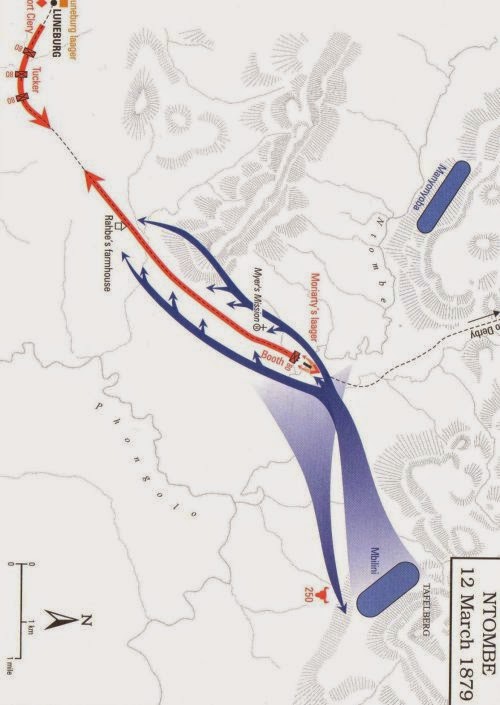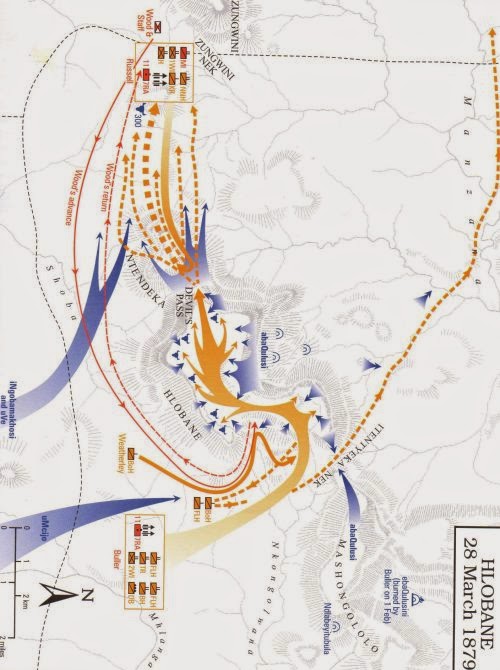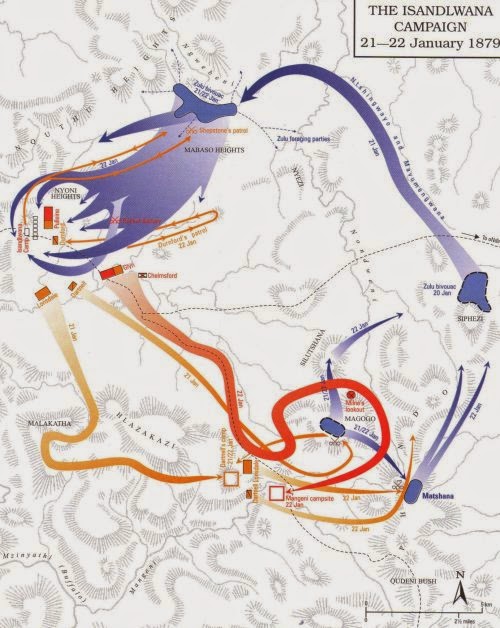
The Battle of Isandlwana on 22nd January 1879 was the first major encounter in the Anglo Zulu War between the British Empire and the Zulu Kingdom. The General ordered the 2nd Battalion 24th Regiment, the Mounted Infantry, and four guns, to be under arms at once to march. The Natal Native Pioneers, about 50 strong, accompanied the force, which marched out from the camp as soon as there was light enough to see the road. Lieutenant Colonel Pulleine, 1st/24th Regiment, was instructed to take command of the camp during the absence of Colonel Glyn the force left with him consisting of 5 x companies 1st/24th and 1 x company 2nd/24th Regiment, 2 x guns Royal Artillery, about 20 x Mounted Infantry and Volunteers 30 x Natal Carbineers, 31 x Mounted Police, and 4 x companies Natal Native Contingent. An order was also despatched to Colonel Durnford at Rorkes Drift to move up to Isandhlwana. Lieutenant Colonel Pulleines instructions for the defence of the camp were, briefly, to draw in his line of defence and infantry outposts, but to keep his cavalry vedettes still far advanced. We may here note that the only country searched was that direct to the front and right front the direction of the wagon track although it is stated the Lieutenant General had himself noticed mounted men in one direction (our left front) on the 21st January 1879, and in this direction he had intended to make a reconnaissance.
After the departure of the advance column nothing unusual occurred in camp until between seven and eight o’clock, when it was reported from the advanced picquet (on the lngqutu range of hills, about 1500 yards to the Major Clery. North) that a body of the enemy could be seen approaching from the north-east and various small bodies were afterwards seen. Lieutenant Colonel Pulleine got his men under arms, and sent a written message off to headquarters that a Zulu force had appeared on the hills on his left front. This was received between 9.30 and 10 A.M.
Colonel Durnford received the Generals order when on an expedition into Natal to obtain wagons, but at once returned to Rorkes Drift, and marched for Isandhlwana. Lieutenant Chard, Royal Engineers, who had ridden to camp for orders, met Colonel Durnford about a quarter of a mile from the camp at the head of his mounted men about 10.30 A.M., and told him the troops were in column outside the camp, and Zulus showing on the crest of the distant hills, several parties working round so far to the left that he was afraid they might be going to make a dash at the Drift. He took orders to Major Russell to hurry up with the rocket battery, to detach a company of Sikali men to protect the baggage, and for all to look out to the left.
Colonel Durnford reached the camp, and received all the information Lieutenant Colonel Pulleine could afford, finding the situation to be Lonsdales natives on outpost duty on the hills to the left, the guns in position on the left of the camp, and the infantry under arms. The oxen were driven into camp and Mr. Brickhill says tied to the yokes, but not inspanned. Constant reports were coming in from the hills to the left. The enemy are in force behind the hills. The enemy are in three columns. One column is moving to the left rear, and one towards the General. The enemy are retiring in every direction. The enemies force was given at 400 to 600.
On hearing these reports, Colonel Durnford sent one troop Natal Native Horse to reinforce his baggage guard two troops to the hills to the left (under Captains G. Shepstone and Barton) one to move along the crest of the range, one to search the valley beyond and determined himself to go out to the front and prevent the one column joining the impi, which was supposed at that time to be engaged with the troops under the General he asked Lieutenant Colonel Pulleine for two companies of the 24th, to which Colonel Pulleine replied, that two companies could ill be spared, but that if Colonel Durnford ordered them, of course they should go. On consideration, Colonel Durnford decided only to take his own men, and moved out with his remaining two troops Natal Native Horse, followed by Major Russells rocket battery, with its escort of a company of Native Contingent, under Captain Nourse.
A company 1st/24th, under Lieutenant Cavaye, was sent out as a picquet to the hills about 1200 yards north of the camp, and the remainder of the troops dismissed to their private parades, where the men were to lie down in readiness to turn out if required. At this time there was no expectation of an attack during the day, and no idea had been formed regarding the probable strength of the enemy.
The two troops sent on the hills to the left to ascertain the enemy's movements, had proceeded about five miles from the camp, when the Zulu army came forward, advancing straight on towards the camp. Captain Shepstone ordered a retreat on the camp, and himself rode in with the warning that the whole Zulu army was advancing to attack it. Captain Shepstone met Captain Gardner on reaching the camp, and both officers then went to Colonel Pulleine, but, says Captain Gardner, the enemy were already on the hill on our left in large numbers. Colonel Durnford, having despatched his two troops to the left, had moved out to the front at a canter, followed at a foots pace by the rocket battery, etc. About five miles out, a trooper rode down from the hills on the left, and reported an immense impi behind the hills, and almost immediately the Zulus appeared in force in front and on the left, in skirmishing order, ten or twelve deep, with supports close behind. They opened fire at about 800 yards, and advanced very rapidly. Colonel Durnford retired a little way to a donga and extended his men, then fell back, keeping up a steady fire, for about two miles, when he came upon the remains of the rocket battery, which (it appeared) had turned to the left on hearing firing on the hills, been cut of, and broken up. Fighting was still going on here, but the Zulus were speedily driven back.
Colonel Durnford retired slowly on the camp, disputing every yard of ground, until he reached a donga about 800 yards in front of the right of the camp there, prolonging the line of the camp troops, and the right being reinforced by between thirty and forty mounted men, under Captain Bradstreet, a stand was made.
This gully, Mr. Brickhill, interpreter to No. 3 Column, says, the mounted force held most tenaciously, every shot appearing to take effect and with the havoc caused by the guns, a thousand Zulu dead must have laid between the conical hill and the gully. They lay just like peppercorns upon the plain.
The two troops of native horse sent to reconnoitre the Ingqutu Hills, retired fighting before the enemy in good order to a crest in the neck which joins Isandlwana to Ingqutu. Leaving their horses well sheltered here, they held this crest splendidly, keeping up a steady galling fire. They were eventually compelled to retire, with the loss of Captain G. Shepstone.
We must now consider what had taken place at the camp. All was quiet till about twelve o’clock, when firing was heard on the hill where the company on picquet was stationed the troops were immediately turned out and formed on the left front of the camp. About this time Captain Gardner, 14th Hussars, arrived with an order from the General, addressed to Lieutenant Colonel Pulleine, to send on the camp equipage and supplies of the troops camping out, and to remain himself at his present camp and entrench it if Captain G. Shepstone reached the camp with his warning about the same time. Colonel Pulleine decided it was impossible to carry out the Generals order, as the enemy were already in great force on the hills to the left. Captain Gardner sent off a message to headquarters, saying that our left was attacked by about ten thousand of the enemy. A message was also sent by Colonel Pulleine.
One company (Captain Mostyns) was moved up to support the picquet the enemy distant about 800 yards, moving towards our left. Orders to retire were received almost immediately, and the whole retired to the foot of the slope, the enemy rushing forward to the crest of the hill as our men disappeared. Captain Younghusbands company was at this time in echelon on the left.
The guns came into action about 400 yards on the left front of the camp, where they were able to throw shells into a large mass of the enemy that remained almost stationary about 3400 yards off. The three advanced companies of the 24th retired on the main body, when the situation was this. The two guns and the whole of the 24th in line, about 300 yards from the left front of the camp the natives took post on the right of the 24th; then came Durnfords Basutos and the extreme right was formed by about forty mounted Europeans the force holding the only position that afforded any shelter, broken ground and a donga in front of the camp the infantry in good position among the stones and boulders to the left and left centre of the camp, and who stood their ground most gallantly. The enemy approached to within about 400 yards, the two guns firing case. The heavy fire from the line told so upon the Zulus that they wavered and lay down they are said to have covered the valley in detached groups to the depth of about three quarters of a mile.
The enemy now began to work round the rear which they could do with impunity owing to the formation of the ground, and Captain Essex says I rode up to Lieutenant Colonel Durnford, who was near the right, and pointed this out to him. He requested me to take men to that part of the field, and endeavour to hold the enemy in check but at this moment, he says, those of the Native Contingent who had remained in action, rushed past us in the utmost disorder, thus laying open the right and rear of the 24th, the enemy dashing forward in the most rapid manner. The ammunition of the mounted troops failing supplies had been repeatedly sent for, but none came, Colonel Durnford retired them towards the right of the camp whore the wagons and ammunition of the Native Horse were, and himself galloped off to the 24th, having previously told Captain Gardner that the position was too extended, and he desired to concentrate the force. Colonel Durnfords intention undoubtedly was to withdraw all the troops to the rising ground on the right of the camp, to which point he had retired his Native Horse.
The Zulus rushed on the left in overwhelming numbers, completely surrounding the 24th. The guns limbered up, and made for the Rorkes Drift Road, but found it blocked by the enemy they therefore followed at crowd of natives and camp followers, who were running down a ravine the Zulus were all among them, stabbing men as they ran Down this ravine the fugitives hastened, the enemy round and among them, the assegai doing its deadly work.
Lieutenant Colonel Pulleine was said by Lieutenant Coghill to have been killed, and during the flight Major Stuart Smith, Royal Artillery. (who had been wounded), Surgeon Major Shepherd, and many a man, mounted and on foot, were killed. The Buffalo was gained at a point about five miles below Rorkes Drift, and numbers of the fugitives were either shot, or carried away by the stream and drowned. Lieutenants Melville and Coghill rode from the camp, on its being carried by the Zulus, the former with the Queens colours of his regiment. These he bore into the river, but lost his horse, and was left struggling in the swift current; Lieutenant Coghill, who had safely crossed, rode in to his assistance, when his horse was shot. These brave young officers succeeded in gaining the Natal shore, but were soon overtaken by the enemy, and died Fighting to the last. The Natal Native Horse escaped with little loss they assisted many in the retreat, which they covered as well as they could, especially under Captain Barton on the banks of the Buffalo. Captain Essex puts the time of the retreat from the camp at about 1.30 P.M.
After this period no one living escaped from Isandhlwana, and it was supposed that the troops had broken, and, falling into confusion, that all had perished after a brief struggle. Nothing was known of the after events of that fatal day for months, till, on the 21st May, the scene of the disaster was revisited, and the truth of the gallant stand made was established.
Orders of Battle
British Commander-in-chief
No. 2 Column (detachment), Brev Col A.W. Durnford, RE, commanding
No. 11 Battery, 7th Brigade, RA 3 x 9 pounder rockets, Major F.B. Russell
Natal Native Horse, Capt G. Barrington
No. 1 Troop Sikali's Horse Lt C. Raw
No. 2 Troop Sikali's Horse Lt J.A. Roberts
No. 3 Troop Sikali's Horse Lt R.W. Vause
Endendale Troop, Lt H.D. Davies
Hlubi's Troop, Lt A.F. Henderson
1st/1st Natal Native Contingent
D company Capt C. Nourse
E company Capt W.R. Stafford
No. 3 Column (detachment), Colonel H.B. Pulleine
N Battery, 5th Brigade RA 2 x 7 pounder guns, Major S. Smith
5th Field Company, Royal Engineers
A company 1st/24th Regiment of Foot, Lt C.W. Cavaye
C company 1st/24th Regiment of Foot, Capt R. Younghusband
E company 1st/24th Regiment of Foot, Lt F.P. Porteous
F company 1st/24th Regiment of Foot, Capt W.E. Mostyn
G company 2st/24th Regiment of Foot, Lt C.D.A. Pope
H company 1st/24th Regiment of Foot, Capt G.V. Wardell
No. 1 Squadron mounted Infantry
Natal Mounted Police
Natal Volunteers Corps, Major Dartnell
Natal Carabineers Lt F.J.D. Scott
Newcastle Mounted Rifles Capt C.R. Bradstreet
Buffalo Border Guard
1st/3rd Natal Native Contingent
No. 6 company Capt R. Krohn
No. 9 company Capt J.F Lonsdale
2nd/3rd Natal Native Contingent
No. 4 company Capt E. Erskine
No. 5 company Capt A.J. Barry
Natal Native Pioneers Corps
No. 1 company
Army Service Corps 90th Regiment of Foot
Army Hospital Corps
Army Medical Department
Zulu Commander-in-chief
Ntshingwayo kaMahole
Mavumengwana kaNdlela
Prince Dabulamanzi kaMapande
Left Horn Regiments
inGobamakhosi
uMbonambi
uVe
Chest Regiments
umKhulutshane
umHlanga
isAngqu
umCijo
Right Horn Regiments
uDududu
uNokhenke
iMbube
Loins at Isandlwana Reserve Regiments that were sent to Rorke’s Drift
uThulwana
uDloko
inDluyengwe
inDlondlo
Download This Scenario
How it Played
Sources



